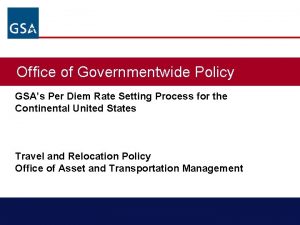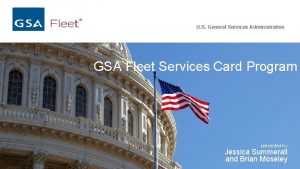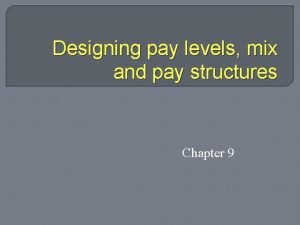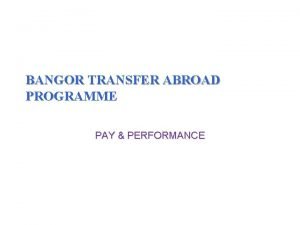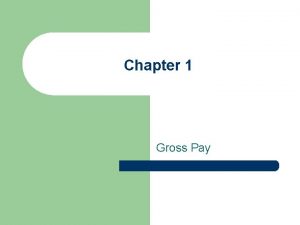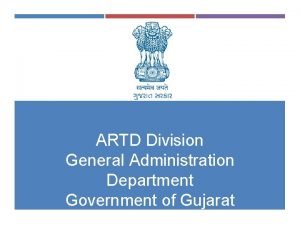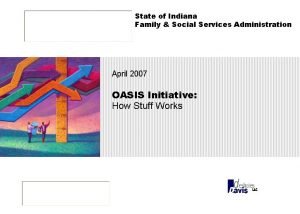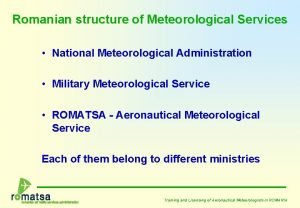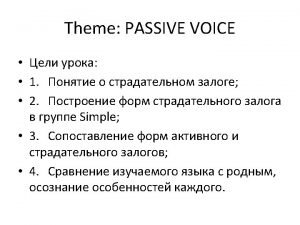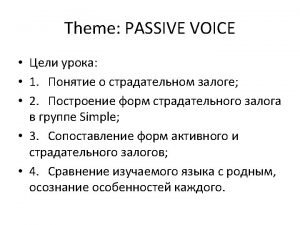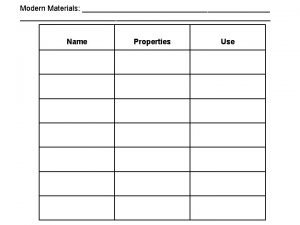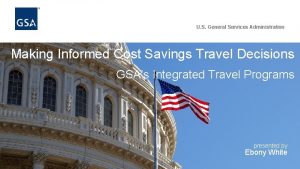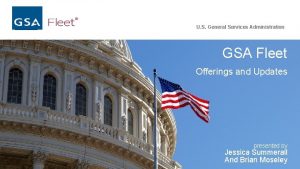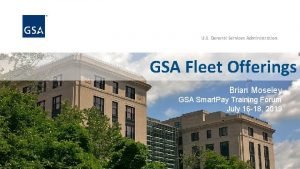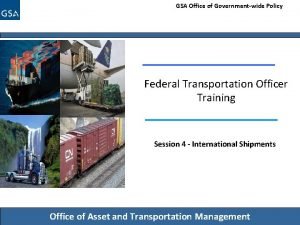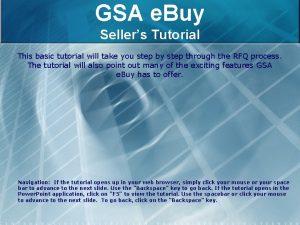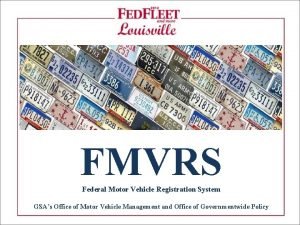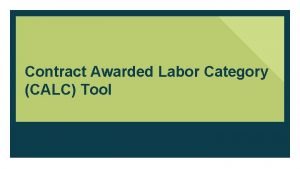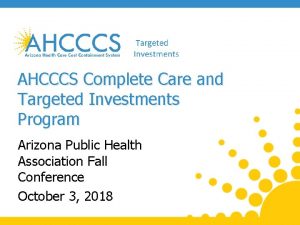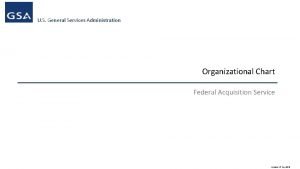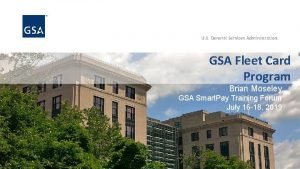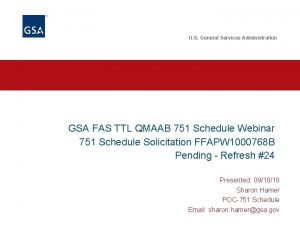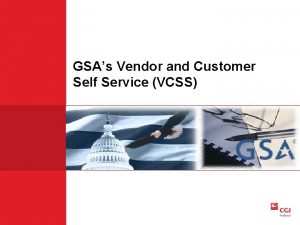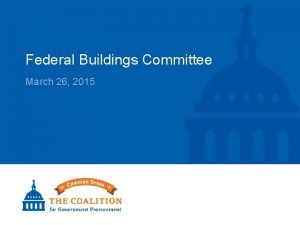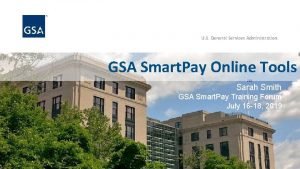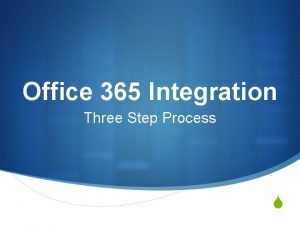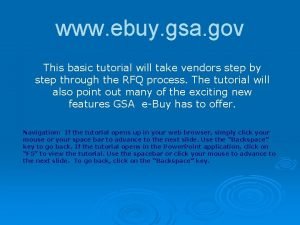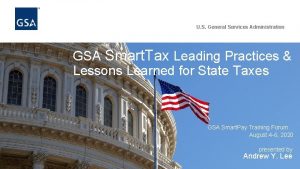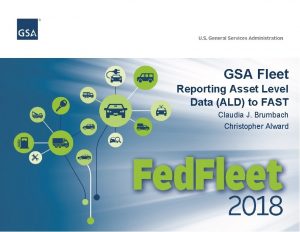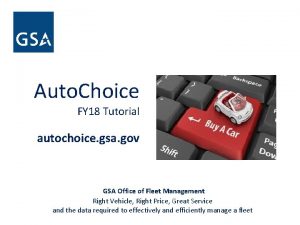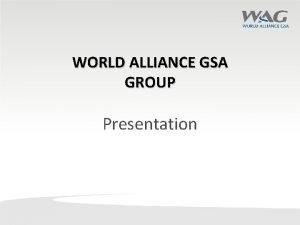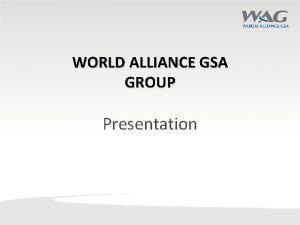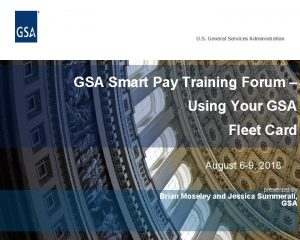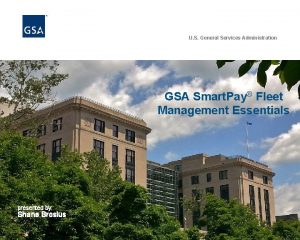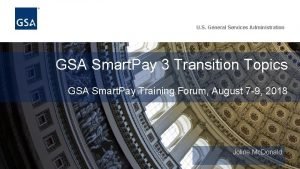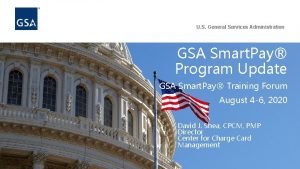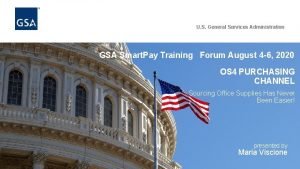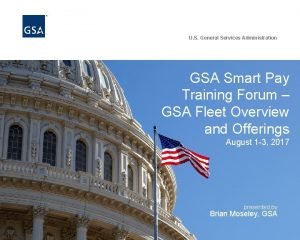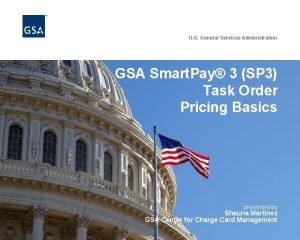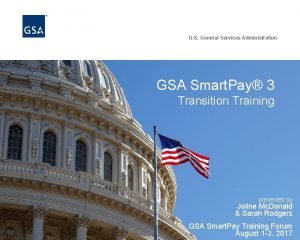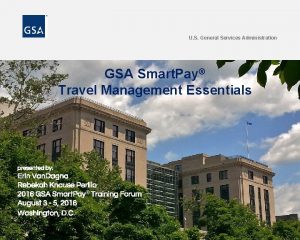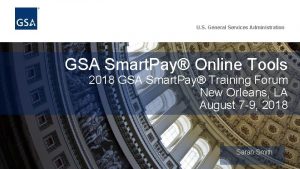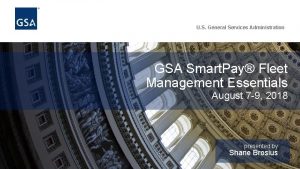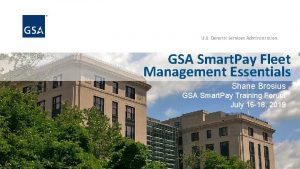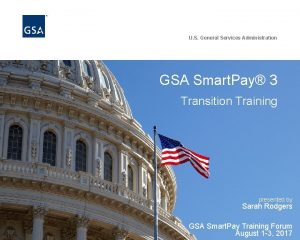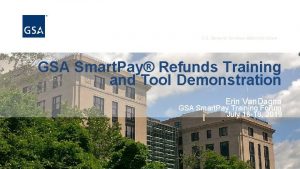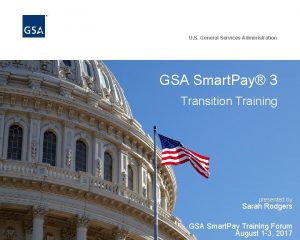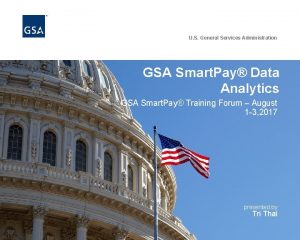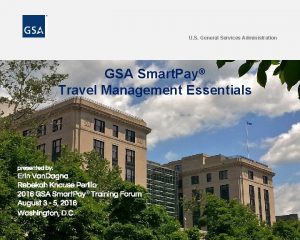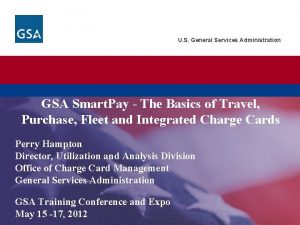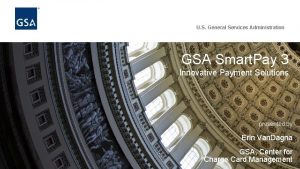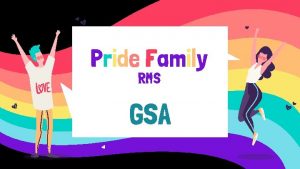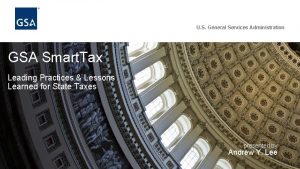U S General Services Administration GSA Smart Pay












































- Slides: 44

U. S. General Services Administration GSA Smart. Pay® Program Update GSA Smart. Pay® Training Forum July 20 -22, 2021 David J. Shea, CPCM, PMP Director Center for Charge Card Management (CCCM)

Agenda 1. GSA Smart. Pay®: 23 Years of Supporting Agency Missions • GSA Smart. Pay® Program History • GSA Smart. Pay® Program Growth • Program Statistics 2. Hot Topics and Recent Developments • Section 889 Part B/Supply Chain Risk Update • Government-to-Government Transactions • New GSA Smart. Pay® Data Visualizations • • COVID Micro-Purchase Transaction Reporting Maintaining Ability to Use Card for Intergovernmental Business 3. Looking to the Future of GSA Smart. Pay® Payments • Increasing Carded Contract Payments • What? No Prompt Pay Penalties? • Common Fictions and Associated Realities • GSA Commercial Platform Status • Not for Micro-Purchases Only! • Travel & Fleet Trends and Opportunities • Make Carded Contract Payments Without the Clause • Case Studies 2

GSA Smart. Pay® Historical Spend and Refunds Sinception, GSA Smart. Pay® has enabled over $580 B in total spend through 1. 9 B transactions, generating over $4. 8 B in agency refunds. GSA Smart. Pay® 1 Begins GSA Smart. Pay® 2 Begins GSA Smart. Pay® 3 Begins $35 B $20 B $15 B $4, 0 B Travel: $161 B Billions $25 B $5, 0 B Fleet: $30 B $3, 0 B Purchase: $389 B Agency Refunds $10 B $2, 0 B $1, 0 B $B $0, 0 B 19 FY 99 20 FY 00 20 FY 01 20 FY 02 20 FY 03 20 FY 04 20 FY 05 20 FY 06 20 FY 07 20 FY 08 20 FY 09 20 FY 10 20 FY 11 20 FY 12 20 FY 13 20 FY 14 20 FY 15 20 FY 16 20 FY 17 20 FY 18 20 FY 19 20 20 $5 B FY Billions $30 B $6, 0 B 3

GSA Smart. Pay® Program Growth Smart. Pay® 1 Smart. Pay® 2 Smart. Pay® 3 Purchase Spend: $158. 7 B $190. 7 B $49. 9 B Travel Spend: $63. 2 B $84. 9 B $14. 5 B Fleet Spend: $9. 0 B $18. 9 B $3. 5 B Total Spend: $230. 9 B $294. 5 B $67. 9 B Total Transactions: 849. 0 M 946. 5 M 180. 3 M Cumulative Agency Refunds: $1. 1 B $3. 0 B $1. 0 B 4

FY 21 YTD Program Statistics Spend Total Spend: Total Transactions: $12. 7 B 31. 0 M 14. 2% vs. FY 20. 29. 0% vs. FY 20. Total Refunds: Total Accounts: $168. 9 M 5. 72 M 37. 6% vs. FY 20. 11. 1% vs. FY 20. Accounts Transactions 5

Hot Topics and Recent Developments 6

Section 889 Part B and Other Supply Chain Risk Issues (1 of 3) • • • 2019 NDAA Section 889 Part B, regarding contractor/merchant use of prohibited technology, went into effect on August 13, 2020 National Security requirements in statute are the primary driver The Federal Acquisition Regulation (FAR) does not require written 889 representations for micro-purchases; agency policies vary 889 requirements do not apply to IBA travel cards, however, note that limitations on the use of certain hotel chains could be issued CCCM issued Smart Bulletin #33 addressing 889 charge card implications and considerations 7

Section 889 Part B and Other Supply Chain Risk Issues (2 of 3) • • • As a best practice, agencies may consider a policy emphasizing the security benefits of cardholders using existing government on-line shopping sites as the first source of supply if practical, such as: GSA Advantage!, Fed Mall, GSA Global Supply, category-managed solutions, agency-specific vehicles, etc. The expectation is that the cognizant contracting office will ensure the required section 889 language is added to the contracts underlying these offerings and their compliance. Even though the FAR does not require written merchant 889 representations for micro-purchases, cardholders nonetheless are required to comply The GSA Smart. Pay® website has a link for the GSA FAS 889 Part B Contract Vehicle Tracking Dashboard which provides a registry of FAS managed acquisition vehicles along with the current 889 Part B FAR clause modification status 8

Section 889 Part B and Other Supply Chain Risk Issues (3 of 3) • • The GSA Smart. Pay® website also includes a list of “prohibited vendors” Note that a new executive order was issued on January 5, 2021 dealing with Chinese connected software applications. Although the basis for this executive order is different from Section 889, the intent is similar but instead addresses Chinese connected software applications used in the United States such as Alipay, Cam. Scanner, QQWallet, SHAREIT, We. Chat Pay, etc. – FAR coverage has yet to be issued. The EO requires the Secretary of Commerce to review these applications before any action is to be taken with regard to these software applications 9

New GSA Smart. Pay® Data Visualizations • As part of ongoing efforts to support effective charge card management, CCCM aims to provide customer agencies timely and useful statistics to enhance program awareness and support decision-making. • In FY 21, CCCM is making a strategic effort to enhance existing visualizations and incorporate new visualizations on the GSA Smart. Pay® public facing website. • The following slides detail several examples that agencies can expect to be able to view and see updated annually on the public facing website 10

Spend and Refunds Since Program Inception $ 35 $ 500 $ 450 $ 400 $ 350 $ 300 $ 250 $ 200 $ 150 $ 100 $ 50 $- $ 30 $ 25 $ 20 $ 15 $ 10 $5 $- Millions Billions New GSA Smart. Pay® Data Visualizations FY FY FY FY FY FY 1999 2000 2001 2002 2003 2004 2005 2006 2007 2008 2009 2010 2011 2012 2013 2014 2015 2016 2017 2018 2019 2020 Purchase Travel Fleet Agency Refunds 11

New GSA Smart. Pay® Data Visualizations Card Present vs. Card Not Present Spend (FY 20) 100% 90% 80% 70% 60% 50% 40% 30% 20% 10% 0% 80, 3% 80, 4% 83, 4% 81, 8% 19, 7% 19, 6% 16, 6% 18, 2% FY 20 Q 1 FY 20 Q 2 FY 20 Q 3 FY 20 Q 4 Card Present Card Not Present 12

New GSA Smart. Pay® Data Visualizations Card Present vs. Card Not Present Transactions (FY 20) 100% 90% 80% 70% 60% 50% 40% 30% 20% 10% 0% 59, 9% 40, 1% FY 20 Q 1 48, 4% 43, 0% 45, 9% 51, 6% 57, 0% 54, 1% FY 20 Q 2 FY 20 Q 3 FY 20 Q 4 Card Present Card Not Present 13

New GSA Smart. Pay® Data Visualizations Card Present vs. Card Not Present Spend by Business Line (FY 20) $12 B $10, 22 B $10 B $8 B $6 B $4 B $2 B $1, 51 B $2, 26 B $826, 55 M $468, 28 M $226, 46 M $B Purchase Travel Card Present Fleet Card Not Present 14

New GSA Smart. Pay® Data Visualizations Millions Convenience Check Volume Over Time $140 $132, 1 $120 $112, 1 $100 $94, 8 $80 $77, 7 $60 $58, 5 $42, 9 $66, 3 $31, 6 $51, 9 $40 $38, 6 $20 $21, 1 $0 FY 11 FY 12 FY 13 FY 14 FY 15 FY 16 FY 17 FY 18 FY 19 FY 20 15

New GSA Smart. Pay® Data Visualizations Thousands Convenience Check Transactions Over Time 450 400 394, 0 350 300 250 172, 2 200 139, 9 150 111, 6 100 87, 4 76, 3 62, 8 52, 0 50 41, 4 0 FY 11 FY 12 FY 13 FY 14 FY 15 FY 16 FY 17 FY 18 FY 19 29, 0 FY 20 16

New GSA Smart. Pay® Data Visualizations Average Spend per Transaction by Business Line $1 200 $1 000 $849 $848 $858 $188 $81 $189 $934 $932 $925 $971 $1 030 $1 082 $800 $600 $400 $188 $200 $0 $81 $189 $64 $188 $47 $190 $50 $201 $53 $206 $54 $80 FY 12 $216 $52 FY 13 FY 14 FY 15 FY 16 FY 17 Purchase Travel Fleet FY 18 FY 19 FY 20 17

COVID Related Micro-Purchase Transaction Reporting • OMB Memo M-20 -21 requires agencies to track COVID-19 related spending. • In response to an OMB request, CCCM worked with both Citibank and US Bank to provide for COVID-19 micro-purchase reporting through their Electronic Access Systems (EAS). Use of this capability is at agency election. • For agencies using this EAS capability, CCCM provides monthly reporting directly to OMB on their behalf. • Agencies not using the EAS must appropriately identify COVID 19 micro-purchase transactions in their internal systems in the event OMB calls for this data. 18

COVID Micro-Purchase Reporting Data $ 42, 38 $ 34, 66 $ 20, 45 ar ch M y ua r br $ 5, 41 Fe ar Ja nu m $ 6, 28 $ 3, 45 y $ 4, 12 be r $ 7, 23 ov e N ct ob O be te m Se p er r t us Au g ly Ju ne Ju ay $ 10, 56 m $ 18, 23 ec e $ 21, 49 D $ 24, 74 M $ 45 $ 40 $ 35 $ 30 $ 25 $ 20 $ 15 $ 10 $5 $- Ap ril Millions GSA Smart. Pay® 3 Spend with EAS “COVID” Identifier (FY 20 & 21) Source: GSA Smart. Pay® 3 contractor banks’ EAS from 28 unique agencies/organizations. Note: This only depicts micro-purchase data and does not capture all COVID-19 related spend outside of banks’ EAS. 19

COVID Micro-Purchase Reporting Data 16, 29 16, 40 13, 97 9, 49 8, 78 ar ch 4, 57 M y ua r ar y br em ec 5, 05 4, 50 Ja nu be r m ov e N ct ob O be te m Se p er r t us Au g ly Ju ne Ju ay 4, 94 Fe 5, 66 4, 13 D 10, 66 M 18 16 14 12 10 8 6 4 2 0 Ap ril Thousands GSA Smart. Pay® 3 Transactions with EAS “COVID” Identifier (FY 20 & 21) Source: GSA Smart. Pay® 3 contractor banks’ EAS from 28 unique agencies/organizations. Note: This only depicts micro-purchase data and does not capture all COVID-19 related spend outside of banks’ EAS. 20

Government-to-Government Transactions • • G 2 G transactions are defined as payments between different agencies (intergovernmental) or within the same agency (intra-governmental). In most instances, these transactions are classified under Merchant Category Codes 9399, Miscellaneous Government Services, 9402, Postage Services. Government Only, 9405, Intra-Government Purchases-Government Only. Under the GSA Smart. Pay® 3 master contract, there are two types of G 2 G transactions defined – interchange-based G 2 G and non-interchange-based G 2 G. Interchange-Based G 2 G Non-Interchange Based G 2 G These payment solutions operate the same as any other charge card transaction, earning refunds in accordance with agency/organization task order. These payment solutions do not earn refunds and instead levy a fixed fee per transaction regardless of the dollar amount of the payment. 21

Government-to-Government Transactions FY 20 Top 10 G 2 G Merchants FY 19 Top 10 G 2 G Merchants GSA/FAS $38. 0 M GSA/FAS $33. 9 M UNICOR $25. 9 M UNICOR $29. 9 M DAPS/DOCUMENT SERVICES $11. 9 M DAPS $13. 8 M DOD FED MALL $6. 5 M OPM-HRS General $8. 6 M GPO WASHINGTON/DISB $5. 1 M GPO WASHINGTON/DISB $5. 6 M OPM-HRS GENERAL $5. 1 M DOD EMALL/FED MALL $5. 2 M MCAS YUMA BILLETING FUND $3. 1 M VET CANTEEN $4. 3 M VET CANTEEN $2. 9 M DOS-FSI REIMBURSEMENT $3. 4 M STUTTGARTPZ LODGING $2. 6 M MCAS YUMA BILLETING FUND $2. 9 M CAMP HUMPHREYS LODGING $2. 2 M STUTTGART PZ LODGING $2. 5 M 22

Government-to-Government Transactions Merchant Category Code FY 19 FY 20 9399 - Government Services, Not Elsewhere Classified $153. 2 M $137. 8 M 9402 - Postage Services-Government Only $69. 9 K $66. 1 K 9405 - Intra-Government Purchases--Government Only $0 $0 Total $153. 2 M $137. 8 M # of Transactions 455, 752 471, 038 Notes: According to the GSA Smart. Pay® contractor banks, the merchants self-select their MCCs. As a result, a large number of state, local and non-government entities show up under the 3 MCCs for G 2 G, namely 9399 (Government Services, Not Elsewhere Classified), 9402 (Postage Services-Government Only) and 9405 (Intra-Government Purchases--Government Only). In order to have a more accurate reporting of G 2 G spend CCCM manually removes the non-Federal government merchants. CCCM also excludes USPS in its G 2 G spend data for GSA Smart. Pay®. 23

Maintaining Ability to Use Card for Intergovernmental Business • • CCCM is participating in a Treasury Bureau of the Fiscal Service (BFS) led inter agency small dollar/high transaction volume inter-agency working group (“working group”) BFS recently acknowledged that use of the purchase card for intergovernmental business may continue, subject to the existing Treasury Financial Manual cap of $24, 999. However, this cap may be reduced beginning October 1, 2022 BFS is working on developing a “streamlined” 7600 “EZ” process for intergovernmental transactions of generally $10, 000 or less This “EZ” process also entails the development and acceptance of “General Terms and Conditions” (GT&Cs) between the parties to the transactions. GT&Cs don’t necessarily need to exist on a transaction-by-transaction basis. BFS stated the EZ process is aimed at existing IPAC transactions between agencies CCCM continues to monitor this situation closely; for agencies that value the flexibility of the streamlined charge card process for intergovernmental transactions, we recommend HQ A/OPCs contact their working group representative to ensure they are aware 24

Looking to the Future of GSA Smart. Pay® Payments 25

Increasing Carded Contract Payments • • • While not all contractors will accept carded payments, these payments continue to be the single largest opportunity for agencies to garner further GSA Smart. Pay program benefits $2. 3 billion in GSA Smart. Pay contract payments in FY 20 Agencies need to ensure appropriate issuance levels to warranted Contracting Officers, authorized ordering officials, payment office officials, etc. to ensure sufficient purchase cards are in place to enable contract payments while maintaining reasonable internal controls 26

Not for Micro-Purchases Only! • FAR 31. 301: • (b) Agency procedures should not limit the use of the Government wide commercial purchase card to micro-purchases. Agency procedures should encourage use of the card in greater dollar amounts by Contracting Officers to place orders and to pay for purchases against contracts established under part 8 procedures, when authorized; and to place orders and/or make payment under other contractual instruments, when agreed to by the contractor. See 32. 1110(d) for instructions for use of the appropriate clause when payment under a written contract will be made through use of the card. (Excerpted text; emphasis added) 27

Make Carded Contract Payments Without the Clause! • • FAR 32. 1110 Solicitation/Contract Prescription and Contract Clauses (d) If payment under a written contract will be made by a charge to a Government account with a third party such as a Government-wide commercial purchase card, then the contracting officer shall insert the clause at 52. 232 -36, Payment by Third Party, in solicitations and contracts. Payment by a purchase card may also be made under a contract that does not contain the clause at 52. 232 -36, to the extent the contractor agrees to accept that method of payment. When the clause at 52. 232 -36 is included in a solicitation or contract, the contracting officer shall also insert the clause at 52. 232 -33, Payment by Electronic Funds Transfer-System for Award Management, or 52. 232 -34, Payment by Electronic Funds Transfer-Other Than System for Award Management, as appropriate. (Excerpted text; emphasis added) 28

What? No Prompt Payment Penalties? • FAR 52. 232. -36 Exempts Carded Payments from Prompt Payment Act requirements: (c) Payment. …Payments made or due by the third party under this clause are not payments made by the Government and are not subject to the Prompt Payment Act or any implementation thereof in this contract…. (Excerpted text; emphasis added) 29

Common Fictions and Associated Realities • Fiction #1: Using cards is “more expensive” due to card-related fees the contractor might charge. • Reality #1: The GSA Smart. Pay program has existed for over 20 years. More than $2 billion in contract payments occurred in FY 20 alone. For the vast majority of transactions, vendors/contractors rarely charge additional fees when paid by card. In fact, efficient vendors typically already build card acceptance into their costs of doing business. But if a vendor intends to charge additional fees, find another vendor or don’t pay that vendor with a carded product. Note every payment system has a cost, whether in time or effort, systems development and maintenance, fees, etc. • Fiction #2: Using a card is more difficult or involves more work. • Reality #2: Not necessarily. The answer depends on your particular agency policies/processes. But how many times are we entering the same data, multiple times, to facilitate payments through the traditional contract payment process? We’ve mapped our agency’s process and found it actually involves the same number of steps or less. But, as with any process change, there will be a learning curve when first adopting a new procedure. 30

GSA Commercial Platform Status • • GSA is implementing the Commercial Platform program as directed in Section 846 of the 2018 NDAA and is partnering with a subset of participating agencies to test the initial proof of concept E-marketplace platform contracts have been awarded to Amazon Business, Fisher Scientific, and Overstock. com The Commercial Platform is presently in a proof of concept mode which provides a limited number of purchase cardholders in each participating agency with access to commercial products within the micro-purchase threshold Depending upon the success of the proof of concept, the platform will be made available to a broader range of cardholders 31

Travel & Fleet Trends and Opportunities • GSA awarded government-wide Rideshare/Ride-hail Blanket Purchase Agreements (BPAs) to Lyft and Uber • Coverage is available in the top 50 markets where government employees travel • Cardholders load their account number into the Uber or Lyft app for auto billing. Agencies earn refunds as they do with other card -based transactions • Your agency works directly with Lyft and Uber to set-up accounts 32

Travel & Fleet Trends and Opportunities The “CHARGE” Act (S. 2193) • • • The Charging Helps Agencies Realize General Efficiencies (CHARGE) Act was signed into law on October 1, 2020. The bill requires the Administrator of GSA to issue guidance to clarify that Federal agencies may use a charge card issued under the GSA Smart. Pay® program for charging Federal electric motor vehicles at commercial vehicle charging stations. Under the GSA Smart. Pay® 3 program, more than 700, 000 fleet cards have already been issued to participating agencies These cards can be used for electric vehicle charging payments at commercial charging stations CCCM issued a Smart Bulletin #36 on March 10, 2021 regarding the Charge Act 33

Case Study #1 • An A/OPC sees the following transaction on a purchase card: Cardholder Name: Cardholder XYZ Acct #: 1234 -56 XX-XXXX-7890 Case ID Transaction Date Amount MCC 1234567 2 -19 -2021 $250. 55 5999 MCC Description Merchant Misc & Specialty Sam’s Ink Retail Mastery 34

Case Study #1 Questions: • What seems questionable about this transaction? • Note MCC and description and merchant name Potential approaches: • Contact cardholder for additional details • Checkout vendor website • Other thoughts or ideas? 35

Case Study #1 Solution: • This purchase certainly looks suspect, but this transaction is an example of where unique agency missions come into play – and judging solely from the transaction data itself would be a mistake. More facts were needed. • In this case, this purchase – from an on-line tattoo ink merchant – was appropriate as part of the cardholder’s agency mission is to test tattoo ink for safety. 36

Case Study #2 • An A/OPC sees the following transaction on a purchase card: Cardholder Name: Cardholder TXL Acct #: 1234 -56 XX-XXXX-1120 Case ID Transaction Date Amount MCC 789101 4 -15 -2021 $3, 055. 27 5021 MCC Description Office and Commercial Furniture Merchant Community Playthings 37

Case Study #2 Questions: • What seems questionable about this transaction? • Checkout MCC and description and merchant name Potential approaches: • Contact cardholder for additional details • Checkout vendor website • Other thoughts or ideas? 38

Case Study #2 Solution: • Again, this purchase certainly looks suspect, but this transaction is an example of where unique agency missions comes into play – and judging solely from the transaction data itself would be a mistake. More facts were needed. • In this case, this purchase – from a furniture vendor – was appropriate in that it was for play equipment for a Federal childcare center. 39

Case Study #3 • An A/OPC sees the following transactions, in rapid succession, on a fleet card: Acct #: 1234 -56 XX-XXXX-8923 Date Units Unit of Measure Unit Cost Product Description Merchant Odometer Tank Capacity Make 10/6/20 24. 76 GA 4. 039 Diesel AAFES 42172 100 International 40

Case Study #3 Questions: • What seems questionable about this transaction? • Is the cardholder “splitting” up a purchase? • What would cause this transaction pattern? Potential approaches: • Consider the vehicle type and fuel capacity • Does a purchase at a gas station versus a truck stop make a difference? • Other thoughts or ideas? 41

Case Study #3 Solution: • Note a diesel truck with a 100 -gallon tank is being fueled here • In this case, this purchase – at an AAFES service station – tripped the sales limit on the gas pump at $100 • The driver therefore had to make 3 transactions to fill the truck • Note that truck stop pump limits are higher • The transactions are appropriate 42

Appreciation Thanks for your time and attention! Have a great forum! david. shea@gsa. gov 43

44
 Us general services administration per diem
Us general services administration per diem Gsa driver id
Gsa driver id How much did wanda pay in taxes this pay period?
How much did wanda pay in taxes this pay period? Designing pay levels mix and pay structures
Designing pay levels mix and pay structures Demotivators and edward deci
Demotivators and edward deci Chapter 1 gross pay answers
Chapter 1 gross pay answers Future smart investing in you answers
Future smart investing in you answers Honours your trust
Honours your trust Artd gujarat
Artd gujarat Indiana family and social services administration
Indiana family and social services administration Romanian air traffic services administration
Romanian air traffic services administration Street smart vs book smart
Street smart vs book smart Smart two men are
Smart two men are It is not how smart you are it's how you are smart
It is not how smart you are it's how you are smart Eight types of intelligence
Eight types of intelligence Gestalt
Gestalt Street smart vs book smart quotes
Street smart vs book smart quotes One smart man he felt smart
One smart man he felt smart Dell financial payments
Dell financial payments Properties of modern materials
Properties of modern materials Planos en cinematografia
Planos en cinematografia Where did general lee surrender to general grant?
Where did general lee surrender to general grant? Dts city pairs
Dts city pairs Gsa str
Gsa str Gsa vehicle leasing guide
Gsa vehicle leasing guide Transportation terminology
Transportation terminology Www.ebuy.gsa.gov
Www.ebuy.gsa.gov Registration system for federal motor vehicles
Registration system for federal motor vehicles Calc tool
Calc tool Steward is the rbha for what gsa
Steward is the rbha for what gsa Fas org chart
Fas org chart Gsa fleet drive thru
Gsa fleet drive thru Gsa fas
Gsa fas Vcss gsa
Vcss gsa Gsa bmo
Gsa bmo Gsa smartpay training quiz answers
Gsa smartpay training quiz answers Gsacom
Gsacom Gsa ebuy gov
Gsa ebuy gov Gsa tax exempt map
Gsa tax exempt map Product detail (gsa advantage
Product detail (gsa advantage Fmvrs license plate
Fmvrs license plate Gsa fleet drive thru
Gsa fleet drive thru Autochoice gsa
Autochoice gsa World alliance gsa
World alliance gsa World alliance gsa
World alliance gsa
